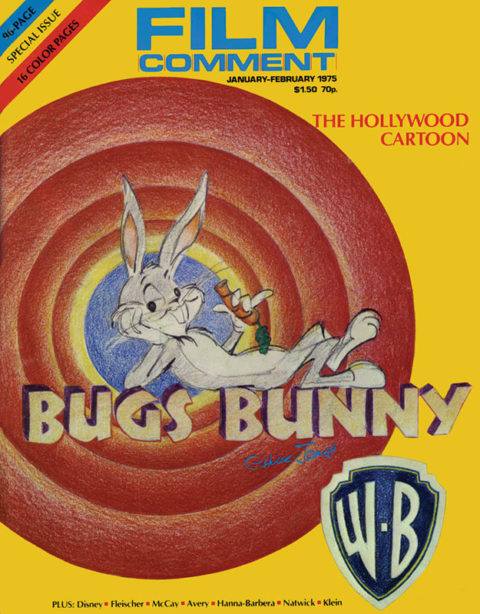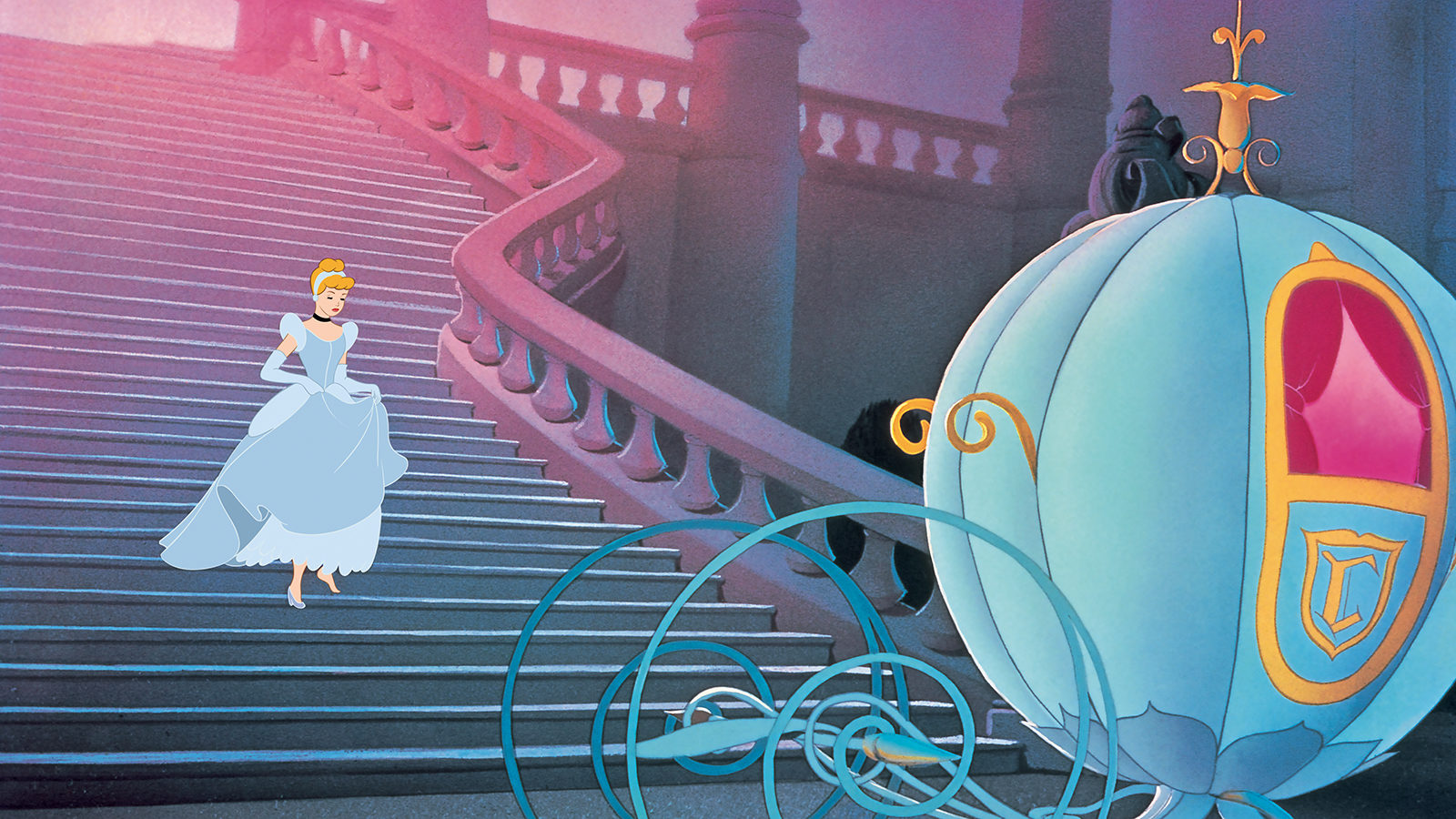
Dream Masters I: Walt Disney
In some respects, there may be no cultural figure in the West who is as potentially controversial as Walt Disney, even though love and hatred for what he represents are frequently felt by the same people. At the same time, there is certainly no other filmmaker whose aesthetical and ideological preoccupations have permeated so much of modern life that, paradoxically, his omnipresence verges on invisibility. Even beyond the grave, continuing manifestations of his vision have become so integral to American society that they are commonly regarded as natural and relatively unquestioned parts of the landscape, like a salt shaker or a babysitter or a place to go on vacation.
It has been reported that in 1966, the year that Disney died, two hundred and forty million people saw at least one of his movies while eight hundred million read a book or magazine bearing his imprint. One would not be unduly surprised to learn that last year the figures were even higher. In an uncharacteristically provocative and rather corrosive account of the opening of Disney World in Newsweek (October 18, 1971), Joseph Morgenstern charged that Walt Disney Productions was “nothing more or less than a royalist plot, a computer program to take over the United States and turn it into a continental Magic Kingdom…
“There is reason to suspect that the Disney interests have done more than install an Audio-Animatronic Nixon in the Hall of Presidents here, that the man in Washington is programmed to abdicate in favor of a Disney-designated ruler.” And why not? Who else but Disney has been able to build an American city that works? All the answers are here. […] What works here can work in a larger Magic Kingdom. […]
“In Walt we can trust to reform our schools and put history in its proper perspective: an Attica land in which Audio-Animatronicized prisoners sing the praises of Governor Rockefeller for respecting their right to privacy, a Thinktankland in which Dan Ellsberg takes the Pentagon papers with a grain of salt. In Walt we can trust to clear the slums, renew the cities, wipe out poverty and the balance-of-payments deficit by putting up turnstiles and charging admission to our shores. It is our manifest destiny to become Disneyland to the world.”
If Morgenstern’s anger sounds exaggerated, it is worth recalling that many years ago, Ray Bradbury quite seriously proposed to Disney that he run for mayor of Los Angeles. As the story is related, the gray eminence was flattered but uninterested: “Why should I run for mayor,” he said, “when I’m already king?” And indeed, one could hardly blame Disney for his response. Why should he have bothered with trifles like managing a city when to minds all over the country he already came across as the benevolent ruler of the universe? How many of us remember Uncle Walt on television, situated in his cozy study with All the World’s Knowledge and All the Great Literary Classics bound in leather—the titles lettered in gold, if we had color TV—presiding benignly over his globe of the world, which he patiently explained and described to us?
It was and is a strange relationship that he had with that globe: not at all like the one that Chaplin had with his own globe in THE GREAT DICTATOR, because it wasn’t subject to easy irony or ridicule—no, it was much too good-natured and paternal for that, too harmless in all of its most obvious implications. Like Mickey Mouse and Donald Duck, whenever or however they appear, it usually makes one smile because it is so cheerfully legible. A critic once remarked to me that much of the continuing excitement of THE GREAT DICTATOR resided in the fact that, when Chaplin made it, he was probably more widely known than any other human on the planet, including Hitler. Whether or not this is true, the mind boggles before the likelihood that the non-human and imaginary Mickey Mouse may be even more universally familiar: according to Lewis Jacobs in The Rise of the American Film (1939), “His popularity outranks that of kings and dictators; he is the best-known figure of the twentieth century.” I don’t know whether he has penetrated Red China yet and I hope he never does, but I rather suspect he is likely to get there in some form or another even before Coca-Cola.
All of this is unsettling, awesome, and extremely problematical to deal with, because, like it or not—and most audiences like it—Disney does embody a specific aesthetic intelligence; and for the past thirty years, intellectuals have generally refused to take him seriously on any level at all. A besetting limitation of Richard Schickel’s useful and factually interesting The Disney Version (Avon Books, 1968) is that it virtually dismisses Disney as an artist while pursuing various sodal implications of his career—as if talent, integrity, and taste were all somehow synonymous and interchangeable. (If one approves of it, it’s art; if one disapproves, it’s mass culture.) And other studies, usually more sympathetic, tend to sing praises to Disney’s “artistry” without seriously acknowledging anything else.
A formidable task faced by any Disney critic is the squaring of art with ideology without distorting the nature or values of either. In the absence of a methodology that can adequately accommodate both aspects, I have limited myself here to a few notes and suggestions, listed under four headings. For the sake of convenience, my range of references has been narrowed to a few of the animated and semi-animated features—not only because these tend to be the best-known works, but also because they appear to be the richest single area for investigation. Unfortunately, the bulk of the early “Silly Symphonies” and many of the features are notoriously difficult to come by, and not having been around for the massive Disney retrospective at Lincoln Center in 1973, I can’t be quite as comprehensive in my use of examples as I’d like to be. A recent Paris revival of SALUDOS AMIGOS, for example, was welcome; but how often does one get to see THE THREE CABALLEROS outside of, say, Buenos Aires? (An Argentine friend has told me that it is quite popular there, and shown almost perpetually.)
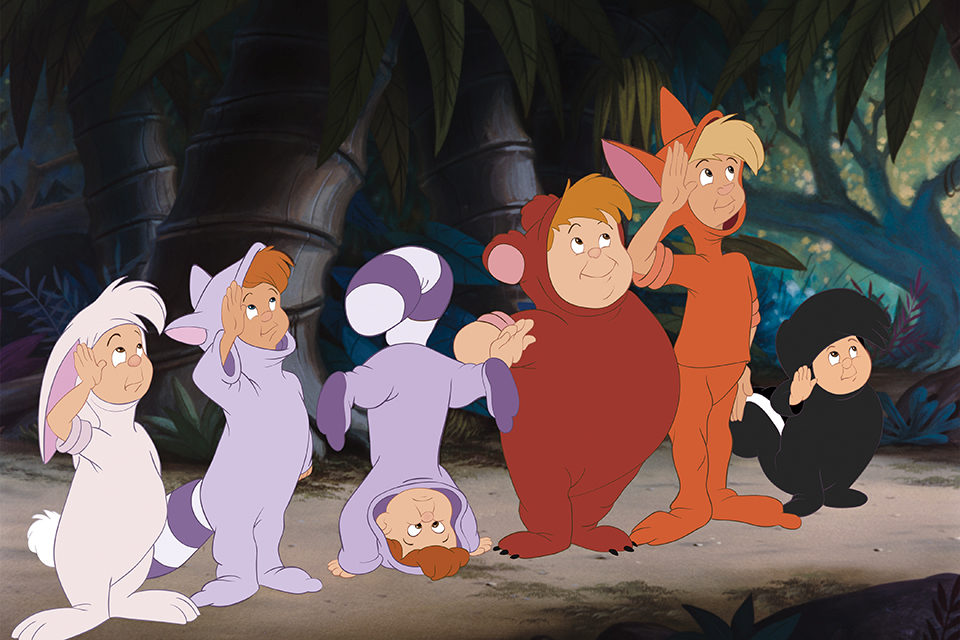
Peter Pan (1953)
(1) Authorship. No one has ever been able to tackle the slippery matter of assigning Disney precise authorship. On the one hand, the cartoon features exhibit a style that is both unmistakable and all-pervasive: a tree in a Disney film is a Disney tree, a doorknob is a Disney doorknob. On the other hand, Disney was not even capable of duplicating the famous “Disney signature” that appears on the credits of each of his films. Five directors are listed on the credits of DUMBO, six in BAMBI, but the Disney style of animation persists as a recognizable entity even up to the present, regardless of who happens to be working at the studio, and despite the frequent modifications (e.g. the influence of U.P.A. animation in ALICE IN WONDERLAND, the even flatter greeting-card perspectives in more recent films like THE ARISTOCATS).
In certain respects, the creative relationship between Disney and his films might be seen as roughly equivalent to the one between Hugh Hefner and Playboy: in and above the multiple contributions, the master fantasy of one individual finds a setting for them all, a “perfect” landscape continually rebuilt, redecorated, and elaborated by others—rather like the made-to-order pornography written for the sole consumption of wealthy À Rebours types, except for the crucial fact that Disney and Hefner both have “cross-section” personalities. There are obviously a lot of people around who feel as ambivalent about sex and nature as Disney and Hefner (respectively) do, and experience much the same mixture of worship and fear in regard to both categories. The wholesomeness projected by the world view of each empire is situated in a porcelain temple of the mind where all notions of waste become magically absent, swept away by water that is kept permanently purified, thanks to beneficent, invisible powers. The categories are thus enabled to maintain their pristine and ideal states: pure idea, without the threat of contamination offered by any experience but a vicarious one.
A man whose highly ambivalent feelings feelings about art were expressed equally well by the term “Silly Symphony” and by his notorious comment after seeing one of the sequences in FANTASIA (“Gee, this’ll make Beethoven!”) may never have resolved these conflicts—he never really had to—but he certainly knew what he liked. And the Disney style might be described as the putting into practice, by countless employees, of what Disney liked.
(2) Style and vision: a comparison. Perhaps the one word that could best encapsulate this style is idealization. It is chiefly this quality that suggests a rather strong parallel between Disney’s vision and Leni Riefenstahl’s—a dream of perfection and simplicity that makes every detail on the screen an expressive part of a continuous animistic whole, implicity turning the entire cosmos into a single idea. THE BLUE LIGHT, Riefenstahl’s first feature, is full of striking correspondences to the cartoon features. It begins with the framing device of a luxurious leather-bound volume being opened to lead us into the story proper; even in Riefenstahl’s glistening blacks and whites, the book’s cover appears to shine with the regal splendor of inlaid gold. The intense pantheism and the towering vistas of the landscape shots, the poetic innocence and purity of the heroine (played by Riefenstahl herself), the telepathy and empathy shown by animals (a lamb and a dog) toward her fluctuating moods, the sheer terror of her flight from angry villagers and the sheer intolerance of their persecution, the misty idealism of the blue light itself shining on a mountain top before the diamonds that provide its source are despoiled by greedy invaders (like the hunters who invade the paradisial forest in BAMBI): all are recognizable features of the Disney kingdom.
Indeed, one could trace this relationship further into certain aspects of the later, better known Riefenstahl films, TRIUMPH OF THE WILL and OLYMPIA. The arrival of Hitler’ s plane over Nuremberg in the former suggests the weightless flights of Peter Pan and Mary Pop pins over London; the monumental low-angle shots of certain Nazi figures echo the camera’s mythic discovery of Bambi’s father, standing proudly on an imposing cliff to witness his son’s birth; the monstrous rally decor (sets by Albert Speer) and its dwarfing of individuals is comparable to the palace in CINDERELLA; the torch-bearing sequence that opens OLYMPIA and the equally remarkable “light show” that concludes it each find rough counterparts in FANTASIA.
As the latter example surely indicates, Riefenstahl is formally much more sophisticated than Disney, and this comparison is not meant to imply direct stylistic influence in either direction or any precise ideological equivalence, but rather to isolate a particular aesthetic attitude that is unusually open to ideology because of its child-like innocence and its predilection for primal myths of unity and perfection.1 As a further indication—if not a demonstration— of the compatibility of these two temperaments, it is worth noting that, according to Robert Gardner (FILM COMMENT, Winter 1965), when Riefenstahl visited the United States in 1938, Disney was “the only film celebrity to greet her publicly, out of the scores that professed to admire her.”
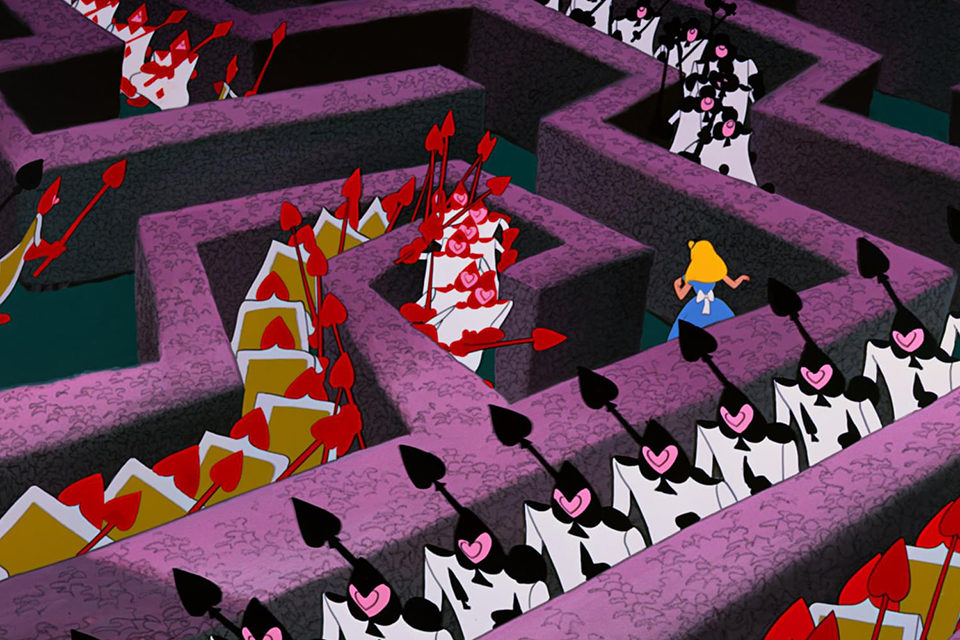
Alice in Wonderland (1951)
(3) Ideological substructures. Conscious and unconscious propaganda of all kinds are observable in the cartoon features. A characteristic and fairly innocuous form of conscious propaganda can be found in the various attempts to persuade children to “behave properly” in SNOW WHITE AND THE SEVEN DWARFS (1937): household chores such as dusting and dish-washing are shown to be “fun”—“Whistle While You Work” (although Snow White appears to do most of the whistling, the animals most of the work)—while another lengthy musical number is devoted to the importance of washing up before eating. The first of Disney’s cartoon features was regarded by many as an enormous financial risk, and it appears likely that a particular effort was made here to please the parents as well as the children.
Probably less conscious are the implications behind the decision to have the dwarfs chase the Wicked Witch up a mountain and to her death (a beautiful, blurred fade-out of two buzzards circling down a chasm after her) before they’ve had a chance to discover that she’s fed Snow White a poison apple—in fact, before they’ve bothered to inquire into Snow White’s welfare at all. Their vengeful pursuit is motivated by nothing but the forest animals’ mute warnings—that is, by pure hysteria—and the Witch’s evil has already been depicted so vividly and persuasively (to us, if not to them) that it is virtually impossible not to share their mob-like response as they goad her to her doom. Curiously, Snow White, who is visibly young enough to be the daughter of any of the dwarfs, acts like a mother towards them, a clever ploy permitting various subliminal satisfactions to children and parents alike. When the dwarfs need affection or guidance, she is maternal; when she needs to be avenged—or protected and preserved in a glass casket for the Prince’s arrival—they assume the parental role.
A sample instance of submerged nationalistic propaganda can be seen in PINOCCHIO (1940). A quick survey of the various nationalities crowded together in the plot reveal a lower-class Italian (Stromboli) and two pseudo-English tricksters (the foxes) as villains;2 the “bad boy” who is Pinocchio’s naughty counterpart is a vulgar Cockney, as is the demonic coachman who transports them both to Pleasure Island; Geppetto, the “father,” is apparently Swiss; Jiminy Cricket, whose attire and movements seem partially derived from the Chaplin tramp, appears to be a subtle blend of English and American attributes. Of the remaining speaking parts, only Pinocchio himself and the maternal fairy watching over him come across as “purely” American, and rather homogenized specimens at that. The bebop crows in DUMBO (1946) are commonly cited as an example of Disney’s racism; but it should be kept in mind that this aspect becomes modified—if not eliminated—in foreign-dubbed versions, which are generally the only versions available in most non-English-speaking countries. (The same, of course, applies to many of the nationalities in PINOCCHIO.) In French, for instance, the crows come across as clochards as much as black stereotypes; the two caricatures become merged and confused.
If the racism of SONG OF THE SOUTH (1946) is infinitely more disturbing and consequential, this is because it bowdlerizes American history with such consummate mastery that its tactics go virtually unnoticed. Aided by the richly textured color photography of Gregg Toland and the frenetic emotional traumas of the plot, the film captures and reflects the consciousness of a child so adroitly that all of its submerged biases are made to ring like simple mythic truths. The physical pain of the cartoon sequences (e.g., Br’er Rabbit and the Briar Patch) alternates with the emotional pain of the live-action (the departure of the boy’s father from the plantation corresponding to the experience of the recently-ended war, when many fathers were away): both lines culminate in the hysterical climax of the boy chasing across a pasture after Uncle Remus, departing on a wagon for Atlanta, before he is charged and gored by a killer bull.
Uncle Remus, who has assumed the parental role of the missing father, has been ordered to stop seeing the boy by the latter’s mother after telling him stories (the interpolated cartoons), which she thinks gets him into various kinds of mischief and trouble, but we know are conventional and respectable moral lessons that have the opposite effect. The impossibility and sheer absurdity of a black slave’s being (in effect) “fired,” sadly packing his meager possessions into a bandanna fixed on the end of a pole, and boarding a wagon for Atlanta, successfully eluded critics and audiences not only in 1946, but in 1972, when the film was reissued (to reap greater profits than ever before), and not because of any sleight-of-hand in the dialogue: quite simply, Uncle Remus’s status as a slave is ignored when it no longer suits the story’s purposes. (His status as a man is similarly held in check by a scene in the plantation kitchen, when it’s clearly established that he’s interested in the presiding mammy only because of her cooking.) He exists as a literal appendage to the boy’s ego-returning, in the last scene, to revive him from a coma—and is scaled down throughout the film to fit this emotional logic. Needless to say, similar “improvements” in history abound in Disneyland and Disney World—executed with comparable skill, and usually received with the same lack of resistance.
(4) Towards an aesthetic evaluation. For critics of the Thirties and early Forties, Disney was an essential figure in the arts. In 1930, Eisenstein declared him to be the most interesting filmmaker in America, and over the decade that followed, Erwin Panofsky praised the early cartoons and “certain sequences” in the later ones as “a chemically pure distillation of cinematic possibilities”; Gilbert Seldes offered many sympathetic critiques; and even E.M. Forster published a brief tribute to Mickey Mouse. Lewis Jacobs’s assessment of Disney in The Rise of the American Film is certainly more likely to raise eyebrows today than it was in 1939:
“In the realm of films that combine sight, sound, and color Disney is still unsurpassed. The wise heir of forty years of film tradition, he consummates the cinematic contributions of Méliès, Porter, Griffith, and the Europeans. He has done more with the film medium since it added sound and color than any other director, creating a form that is of great and vital consequence not only for what it is but for what it portends. He is the first of the sight-sound-color film virtuosos, and the fact that he is still young and still developing makes him an exciting and important figure to watch.”
But by the middle Forties, after the commercial failure of FANTASIA and several government-supported films led Disney to a more mercantile attitude towards his productions, his critical reputation was already on the decline. And by the middle Sixties, one could say that he was more generally regarded as anything but an artist—at any rate, something much closer to Henry Ford than to John Ford—to the extent that Richard Schickel could confidently assert in The Disney Version, without apparent fear of contradiction, that “Our environment, our sensibilities, the very quality of both our waking and sleeping hours, are all formed largely by people with no more artistic conscience and intelligence than a cumquat.”
For Panofsky, Disney’s “fall from grace” occurred when “SNOW WHITE introduced the human figure and when FANTASIA attempted to picturalize The World’s Great Music.” Today this judgment sounds a little too pat, although it is easy enough to see what he meant. It was probably inevitable that once Disney took on the challenge of cartoon features he would come closer to the conventions of non-animated Hollywood films and further away from the relative abstractness and “purity” of the early “Silly Symphonies,” at least in the overall breadth of his films.
But one also suspects that Disney was kept in the Pantheon as long as he remained a novelty, and dismissed as soon as he became commonplace—a ruling that has little to do with the intrinsic worth of his separate films, and a great deal to do with shifting fashions. One might add that the use of the human figure and the musical pretensions of FANTASIA were already implicit in the anthropomorphism and use of music in the earlier cartoons, and a case could certainly be made that what Disney lost in purism he gained in proficiency.
SNOW WHITE AND THE SEVEN DWARFS is rich with a kind of pictorial beauty that is light years ahead of the crude barnyard effects of the early Mickey Mouse efforts; and it is more than incidentally graced by a score (music by Frank Churchill, words by Larry Morey) that is probably superior to that of any musical released the same year.3 The fairy-tale castle occupied by the Witch—a lovely construction that seems to combine aspects of Brueghel’s Tower of Babel with a distillation of almost every other storybook dream palace—is so rich in suggestions that a near-replica, on which former Disney employees collaborated, wound up serving admirably as Xanadu in the powerful opening shots of CITIZEN KANE: not only the long-shot vista of it standing on a mountain, but virtually the same lap dissolve to an almost identical grilled window in the subsequent closer shot. In a more general way, the water effects in the bottom of a well and in a stream are animated with a translucent brilliance that recalls some of the watery dissolves in Murnau’s SUNRISE, while the throbbing lights and billows of magical smoke in the Witch’s laboratory evoke some of the look of his FAUST.
If SNOW WHITE and PINOCCHIO can be said to take on a related visual aspiration, this appears to be—at least intermittently—a recreation of the silent German “expressionist” cinema in color and sound, simplified, abstracted, and “perfected” to the point were characters are truly continuous with the decor, and actors are no longer strictly necessary, except as disembodied voices for the speaking parts. But SNOW WHITE surpasses PINOCCHIO in its stylistic integration of character with character, and of characters with settings. The forest animals are carefully individuated, and yet, like the crowds in METROPOLIS. they often seem to breathe and move—implicitly, feel and think—in a common pulse. The same paradox applies, of course, to the seven dwarfs: they are both a gallery of distinct types and the interworking parts of a continuous organism, like fingers in a fist.
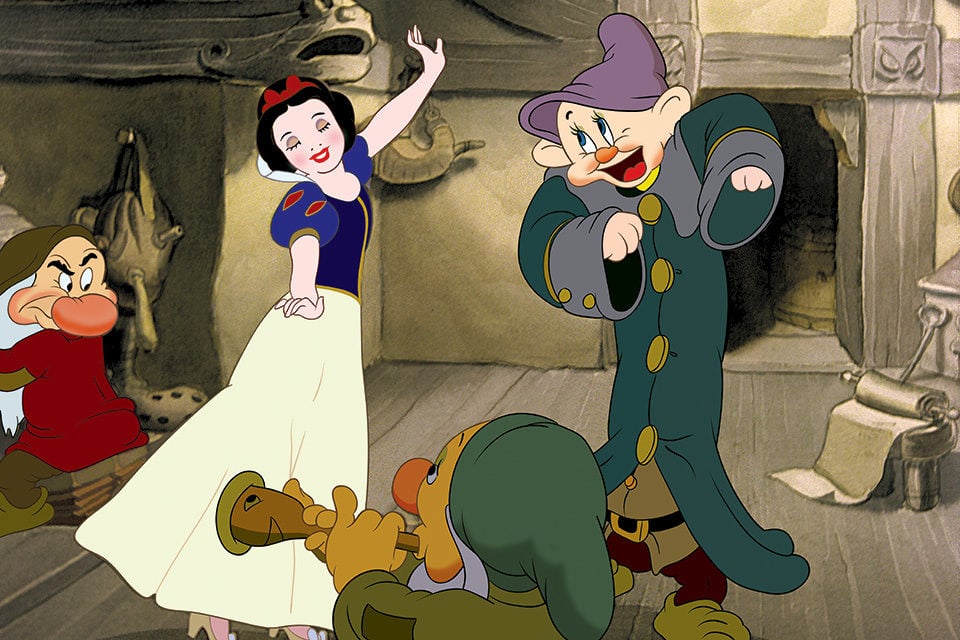
Snow White and the Seven Dwarfs (1937)
Perhaps the pinnacle of Disney’s pictorial achievement is to be found in the Dance of the Pink Elephants in DUMBO (a film, incidentally, that appeared not long after the alleged decline announced by Panofsky). This prodigious dream sequence, with its continual shifts of color, shape, and scale to match the metamorphoses of dream-elephants into a variety of apparitions—beginning as champagne bubbles, and ending as clouds—could probably be stacked against any of the “Silly Symphonies” for formal beauty, purity, imagination, lack of pretension, and its use of music: for its surrealist terror, it even approaches some of the best of Tex Avery. On the other hand, one cannot call the sequence an entirely original one: some of the beasties and their transformations can be partially traced back to the early sound masterpieces of Max Fleischer.
Nothing else in DUMBO quite equals this, although scenes of a train arriving in a small town at night and a circus tent being erected in the rain have a sullen poetry that unexpectedly evokes some of the paintings of Edward Hopper. There is a tendency for most of the features to break down into separate sequences, from the best (PINOCCHIO, DUMBO, ALICE IN WONDERLAND) to the worst (THE LADY AND THE TRAMP, SLEEPING BEAUTY, THE SWORD IN THE STONE). As Marie-Therese Poncet and others have noted, FANTASIA is nearly always discussed as a feature when it is in fact a collection of shorts, and this applies to most of the other “feature” cartoons as well.4
One of the most interesting things about SALUDOS AMIGOS (1947) is the various transitions between abstract and concrete approaches to the same subject. In live-action, we see Disney animators crossing sections of South America by plane, sketching different forms of local color while the narrator rattles off canned itineraries and cultural. tidbits (“The music is strange and exotic,” etc.); eventually the sketches become cartoons. The cartoons, in turn, go from abstract to concrete and back again: each begins with a plane flying over not so much a country as a three-dimensional map, like the opening shot of Florida in DUMBO, with cities and countries indicated by printed names—a chip off of Uncle Walt’s globe so to speak. This becomes a more concrete location as soon as the plane lands. And then the cartoon might turn relatively abstract again, as in the semi-drippy final sequence, “Watercolor of Brazil,” which culminates in arty silhouette effects after red drops of paint turn into storks, yellow drops into bananas, and then the bananas into crows. Or on a more subtle level, the visually prosaic antics of Donald Duck as a naive and affable American tourist suddenly becomes a kitsch extravaganza of pictorial and color values, as duck and assorted pottery go toppling down a mountain slope into the sea, while the bay is lit by a sunset that resembles a hemorrhage. Like some of the train shots in DUMBO, it is calendar art raised to a level of stupefied genius.
Even more than other Hollywood features, Disney’s are manifestly factory products in which the personalities and efforts of scores of individuals are blended and absorbed, including influences from previous films: much as Howard Hawks borrows from CASABLANCA in TO HAVE AND HAVE NOT, the sequence about Pedro the Plane in SALUDOS AMIGOS seems to owe something to Hawks’s ONLY ANGELS HAVE WINGS. With so many identities at play in the features, it should come as no surprise that so many of them are uneven. The extraordinary thing is that such teamwork often worked as well as it did. In BAMBI, a lyrical grasp of the textures, colors, and shapes of plant life is juxtaposed with a vulgar anthropomorphism in the animals that implies an antithetical approach and attitude towards nature—analogous, perhaps, to the cosmetic “improvements” made on Hugh Hefner’s Playmates over the years, particularly when pubic hair was excluded.
More than one commentator has compared Hefner to Disney, particularly as a businessman with a genius for spin-offs and a capacity to use various products as advertisements for still other products. For those interested in tracing the geneology of Playboy‘s rabbit symbol and its multiple manifestations, it is tempting to recall all the ingenious repetitions of rabbit-shapes in the house of the March Hare in ALICE IN WONDERLAND (in the furniture, decor, family portraits, etc.): Disney’s ALICE appeared in 1951, the first issue of Playboy two years later.
***
I have a special fondness for a chummy Disney horse who appears in drag both in the Goofy-gaucho section of SALUDOS AMIGOS and the second half of ICHABOD AND MR. TOAD. (If it isn’t exactly the same character, they’re very close relatives.) Does my liking for that horse reflect a dislike or fear of real horses, or does it make me like real horses more? I suspect it somehow manages to do both.
I have no particular fondness for scorpions. But when I see the mating movements of a couple of them synchronized to square-dance music in one of the True-Life Adventures, I feel that a crime is being committed. Not so much a crime against scorpions—I imagine they couldn’t care less—as a crime against me and my relationship to scorpions.
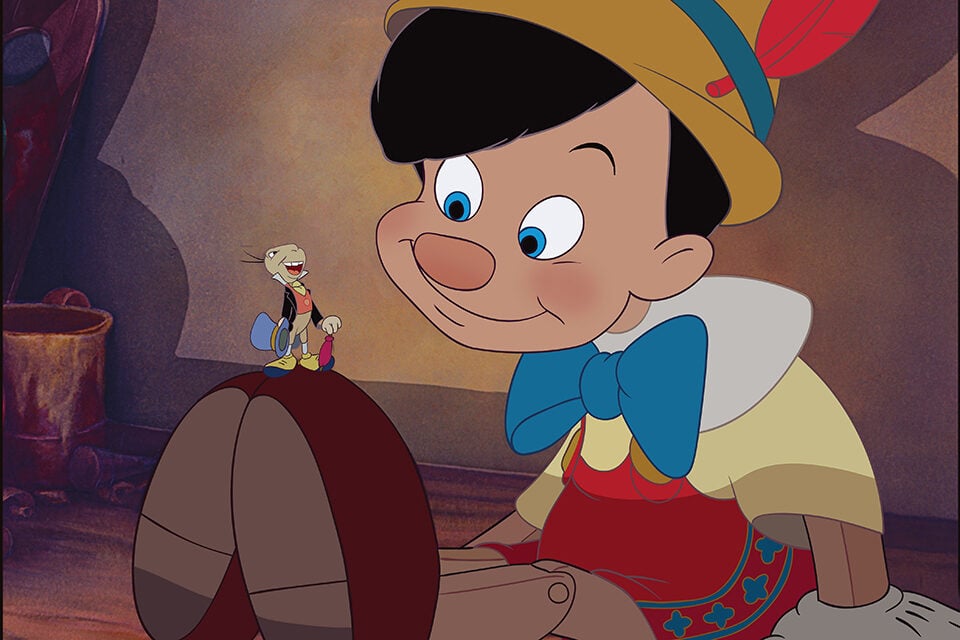
Pinocchio (1940)
***
A day at Disneyland, August 1971. It looks even newer than it did in 1956, the first and only other time that I visited. Technologically, it was and is one of the most extraordinary things in America. Who could blame Khrushchev for wanting to see it? Everyone appeared to assume at the time that he must have been joking; but even cinematically, there’s much more of interest in Disneyland than one could have conceivably found on the set of CANCAN at the Fox studios.
In the Haunted House here—one of the undisputed masterpieces of the park, and a relatively recent addition—the programmed effects are nearly all heightened developments of cinematic possibilities and principles. You step first into a circular low-ceiling waiting-room decorated with family portraits; the doors close, the lights dim, the walls grow higher and higher and the family portraits stretch out accordingly, until eventually it’s like being at the bottom of a well. The doors open, and everyone gets into little cars—continues on a journey up and down hills in a nocturnal setting, through a graveyard; past a disembodied and speaking female head that’s clearly a projected (but three-dimensional) image; countless other delights. It is as “purely cinematographic” as the flight of Mephisto over western Europe in Murnau’s FAUST, just as the “trip sequence in 2001: A SPACE ODYSSEY is partially echoed in a Trip into the Cyclotron ride in Tomorrowland. On your way out of the Haunted House, your car passes a mirror which reveals that a grinning ghoul is sitting next to you.
Film is also centrally used in the Trip to the Moon, to depict simultaneously the receding Earth and the approaching satellite. Straight movie theaters and projections of various kinds are in evidence everywhere. And what is Main Street, U.S.A. which stands at the entrance gate, but the set for a nostalgia film like STRAWBERRY BLONDE or MEET ME IN ST. LOUIS? Disney once gave an interesting account of its governing principle: “It’s not apparent at a casual glance that this street is only a scale model. We had every brick and shingle and gas lamp made five-eights true size. This costs more, but made the street a toy, and the imagination can play more freely with a toy. Besides, people like to think their world is somehow more grown up than Papa’s was.”
Midnight or so, passing back through the gates and in to the cosmic reaches of the Disneyland parking lot, I look up at a dazzling skyful of stars, every constellation in its appointed place—stars poised and ready like raindrops about to fall. Are they Disney’s too?
***
Ultimately, the strengths and weaknesses of Disney’s art are both bound up in its well-preserved and self-sustaining innocence, its refusal or inability to move beyond a child’s perspective. Within these boundaries, its capacity to elicit certain emotions is uncanny: at least half of the people I know were scared out of their wits by the Wicked Witch in SNOW WHITE when they were children—as I recall, I was pretty jumpy myself—and to recognize Disney’s power and preeminence as the Supreme Heartcrusher today, all one has to do is witness the forcible separation of Dumbo from his mother at a kids’ matinee, where the scene will invariably produce a disconsolate chorus of howls. And apart from the terror, there is all the cute, cuddly humor, frequently built around a kitsch dream of the Arcadia myth or the awkwardness or mere embarrassment of being a child in certain situations; d., respectively, the nauseating centaurs moved around to Beethoven’s “Pastoral” in FANTASIA. the turtle painfully making its way up a flight of stairs in SNOW WHITE.
The probable key to Disney’s success is that he has shown himself capable of understanding the way that children think and feel better than any other filmmaker of his time. The question that remains is how wisely and how well he put this special understanding to use. I don’t think it’s a question that children alone can answer, and I don’t think it can be answered simply; I suspect that a lot of us are going to continue to be bothered by it, and bothered a lot, for a very long time.
1. If Riefenstahl’s style and vision have any other contemporary echoes. the se are to be found. perhaps, in some of the exhilarations of Michael Wadleigh’s WOODSTOCK, the TRIUMPH OF THE WILL of Sixties counter-culture, which uses its split-screen images and stereo-sound to create an epic portrayal of Consensus, which the audience is invited to lean back and absorb like a three-hour bath. A crucial cross-reference to Riefenstahl and WOODSTOCK is, of course, Cecil B. De Mille.
2. Otis Ferguson has observed that the lead fox can be traced back to John Barrymore, the goldfish to Betty Boop.
3. At least three of its songs—“Someday My Prince Will Come,” “Heigh-Ho,” “One Song”—have entered the jazz repertoire and served as graceful frameworks for improvisations by Miles Davis, Bill Evans, Dave Brubeck, and many others (a practice initiated by Brubeck, although Davis made it fashionable). Other “Disney” songs to have served this function include “When You Wish Upon a Star” and “Give a Little Whistle” from PINOCCHIO, “Alice in Wonderland,” and “Chim Chim Cheree” from MARY POPPINS—the latter performed by John Coltrane.
4. Poncet is probably the most exhaustive of the French Disney critics; cf. in particular her L’esthetique du dessill animé (A.G. Nizet, 1952).



